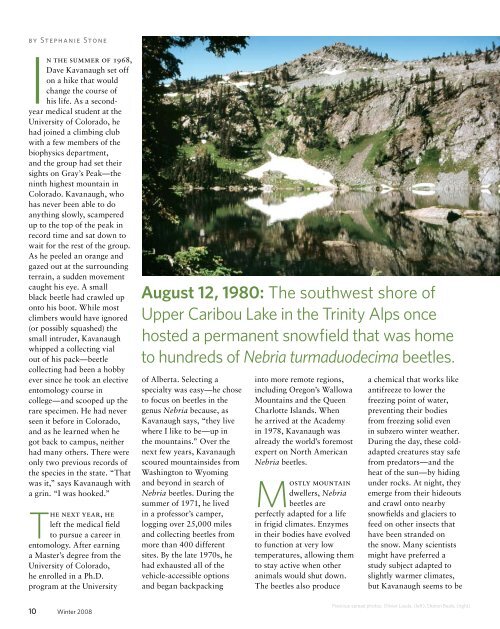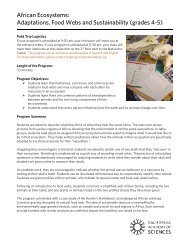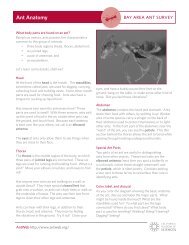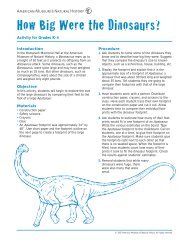Squawk of the town: Academy receives Platinum rating - California ...
Squawk of the town: Academy receives Platinum rating - California ...
Squawk of the town: Academy receives Platinum rating - California ...
You also want an ePaper? Increase the reach of your titles
YUMPU automatically turns print PDFs into web optimized ePapers that Google loves.
y Stephanie Stone<br />
In <strong>the</strong> summer <strong>of</strong> 1968,<br />
Dave Kavanaugh set <strong>of</strong>f<br />
on a hike that would<br />
change <strong>the</strong> course <strong>of</strong><br />
his life. As a secondyear<br />
medical student at <strong>the</strong><br />
University <strong>of</strong> Colorado, he<br />
had joined a climbing club<br />
with a few members <strong>of</strong> <strong>the</strong><br />
biophysics department,<br />
and <strong>the</strong> group had set <strong>the</strong>ir<br />
sights on Gray’s Peak—<strong>the</strong><br />
ninth highest mountain in<br />
Colorado. Kavanaugh, who<br />
has never been able to do<br />
anything slowly, scampered<br />
up to <strong>the</strong> top <strong>of</strong> <strong>the</strong> peak in<br />
record time and sat down to<br />
wait for <strong>the</strong> rest <strong>of</strong> <strong>the</strong> group.<br />
As he peeled an orange and<br />
gazed out at <strong>the</strong> surrounding<br />
terrain, a sudden movement<br />
caught his eye. A small<br />
black beetle had crawled up<br />
onto his boot. While most<br />
climbers would have ignored<br />
(or possibly squashed) <strong>the</strong><br />
small intruder, Kavanaugh<br />
whipped a collecting vial<br />
out <strong>of</strong> his pack—beetle<br />
collecting had been a hobby<br />
ever since he took an elective<br />
entomology course in<br />
college—and scooped up <strong>the</strong><br />
rare specimen. He had never<br />
seen it before in Colorado,<br />
and as he learned when he<br />
got back to campus, nei<strong>the</strong>r<br />
had many o<strong>the</strong>rs. There were<br />
only two previous records <strong>of</strong><br />
<strong>the</strong> species in <strong>the</strong> state. “That<br />
was it,” says Kavanaugh with<br />
a grin. “I was hooked.”<br />
The next year, he<br />
left <strong>the</strong> medical field<br />
to pursue a career in<br />
entomology. After earning<br />
a Master’s degree from <strong>the</strong><br />
University <strong>of</strong> Colorado,<br />
he enrolled in a Ph.D.<br />
program at <strong>the</strong> University<br />
August 12, 1980: The southwest shore <strong>of</strong><br />
Upper Caribou Lake in <strong>the</strong> Trinity Alps once<br />
hosted a permanent snowfield that was home<br />
to hundreds <strong>of</strong> Nebria turmaduodecima beetles.<br />
<strong>of</strong> Alberta. Selecting a<br />
specialty was easy—he chose<br />
to focus on beetles in <strong>the</strong><br />
genus Nebria because, as<br />
Kavanaugh says, “<strong>the</strong>y live<br />
where I like to be—up in<br />
<strong>the</strong> mountains.” Over <strong>the</strong><br />
next few years, Kavanaugh<br />
scoured mountainsides from<br />
Washington to Wyoming<br />
and beyond in search <strong>of</strong><br />
Nebria beetles. During <strong>the</strong><br />
summer <strong>of</strong> 1971, he lived<br />
in a pr<strong>of</strong>essor’s camper,<br />
logging over 25,000 miles<br />
and collecting beetles from<br />
more than 400 different<br />
sites. By <strong>the</strong> late 1970s, he<br />
had exhausted all <strong>of</strong> <strong>the</strong><br />
vehicle-accessible options<br />
and began backpacking<br />
into more remote regions,<br />
including Oregon’s Wallowa<br />
Mountains and <strong>the</strong> Queen<br />
Charlotte Islands. When<br />
he arrived at <strong>the</strong> <strong>Academy</strong><br />
in 1978, Kavanaugh was<br />
already <strong>the</strong> world’s foremost<br />
expert on North American<br />
Nebria beetles.<br />
Mostly mountain<br />
dwellers, Nebria<br />
beetles are<br />
perfectly adapted for a life<br />
in frigid climates. Enzymes<br />
in <strong>the</strong>ir bodies have evolved<br />
to function at very low<br />
temperatures, allowing <strong>the</strong>m<br />
to stay active when o<strong>the</strong>r<br />
animals would shut down.<br />
The beetles also produce<br />
a chemical that works like<br />
antifreeze to lower <strong>the</strong><br />
freezing point <strong>of</strong> water,<br />
preventing <strong>the</strong>ir bodies<br />
from freezing solid even<br />
in subzero winter wea<strong>the</strong>r.<br />
During <strong>the</strong> day, <strong>the</strong>se coldadapted<br />
creatures stay safe<br />
from predators—and <strong>the</strong><br />
heat <strong>of</strong> <strong>the</strong> sun—by hiding<br />
under rocks. At night, <strong>the</strong>y<br />
emerge from <strong>the</strong>ir hideouts<br />
and crawl onto nearby<br />
snowfields and glaciers to<br />
feed on o<strong>the</strong>r insects that<br />
have been stranded on<br />
<strong>the</strong> snow. Many scientists<br />
might have preferred a<br />
study subject adapted to<br />
slightly warmer climates,<br />
but Kavanaugh seems to be<br />
10 Winter 2008<br />
Previous spread photos: Olivier Laude, (left), Sharon Beals, (right).



![download [PDF - 2.7mb] - California Academy of Sciences](https://img.yumpu.com/26596748/1/190x122/download-pdf-27mb-california-academy-of-sciences.jpg?quality=85)








![Download a visitor map [418k] - California Academy of Sciences](https://img.yumpu.com/26596645/1/190x88/download-a-visitor-map-418k-california-academy-of-sciences.jpg?quality=85)



